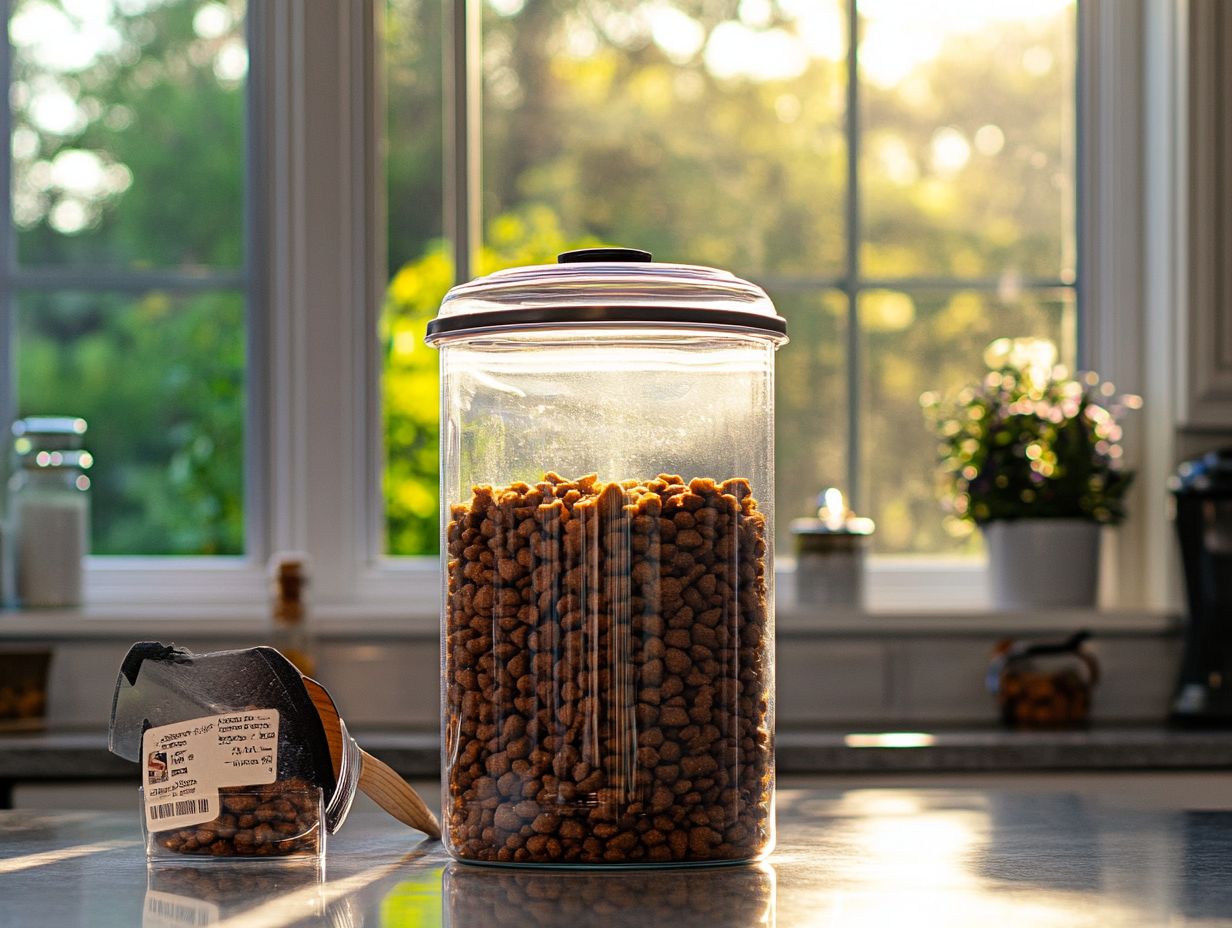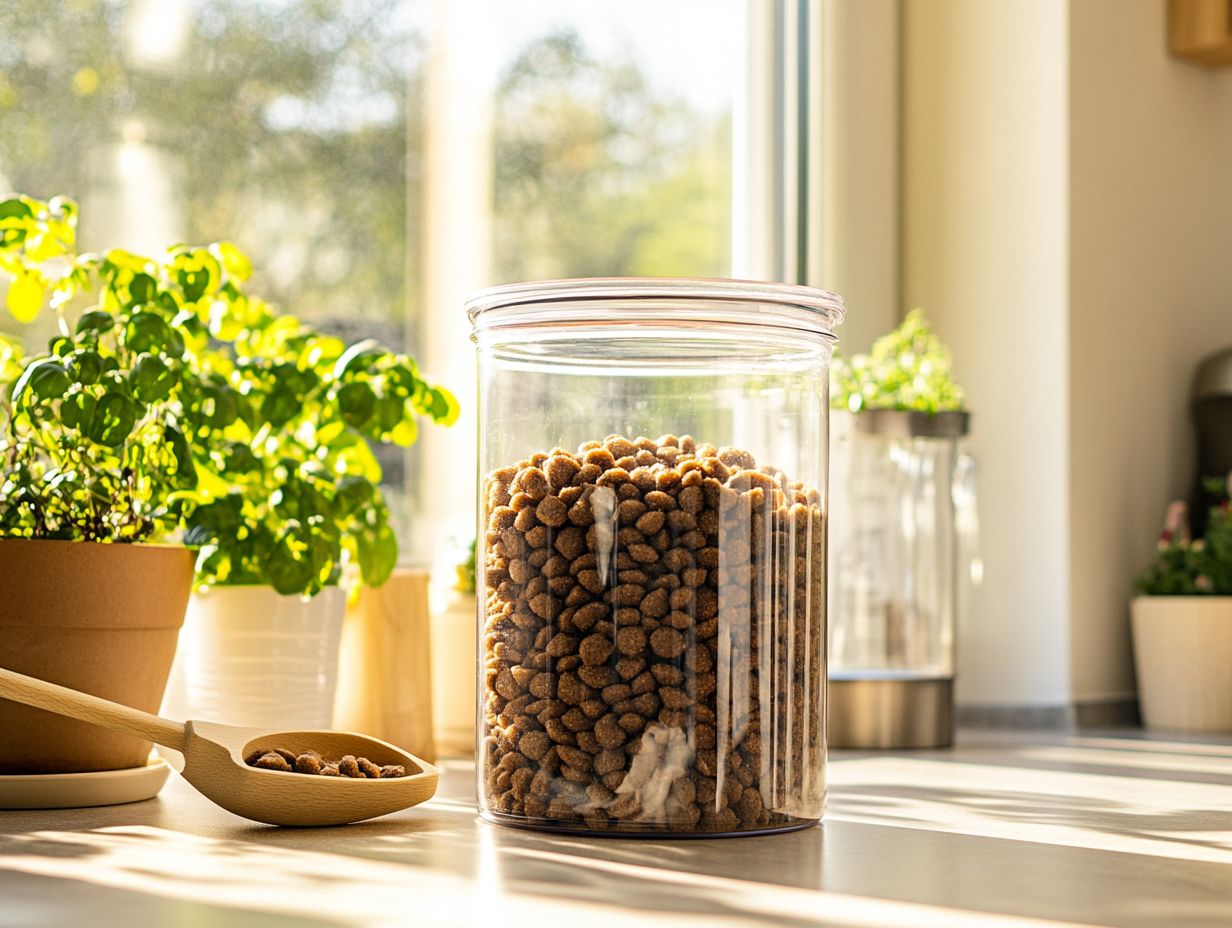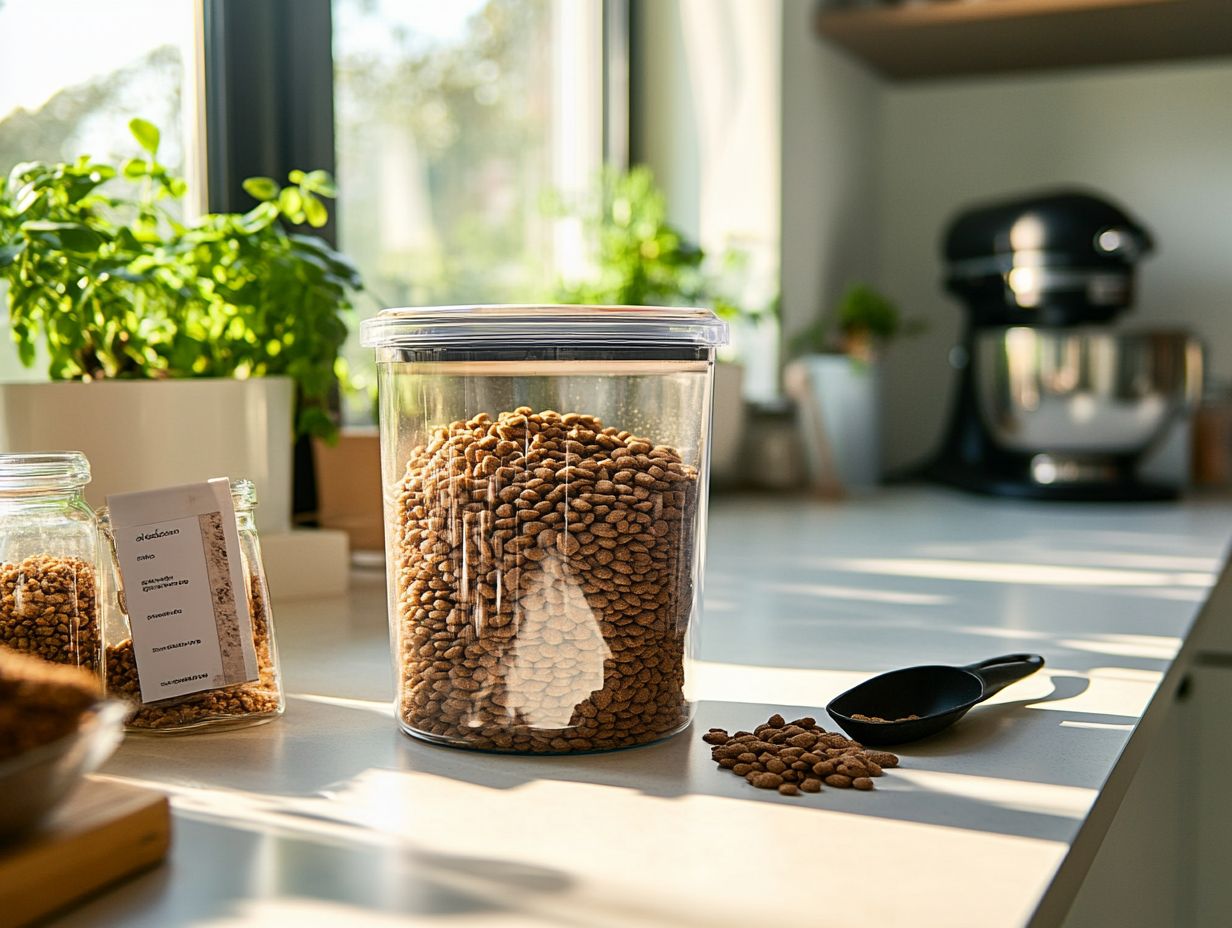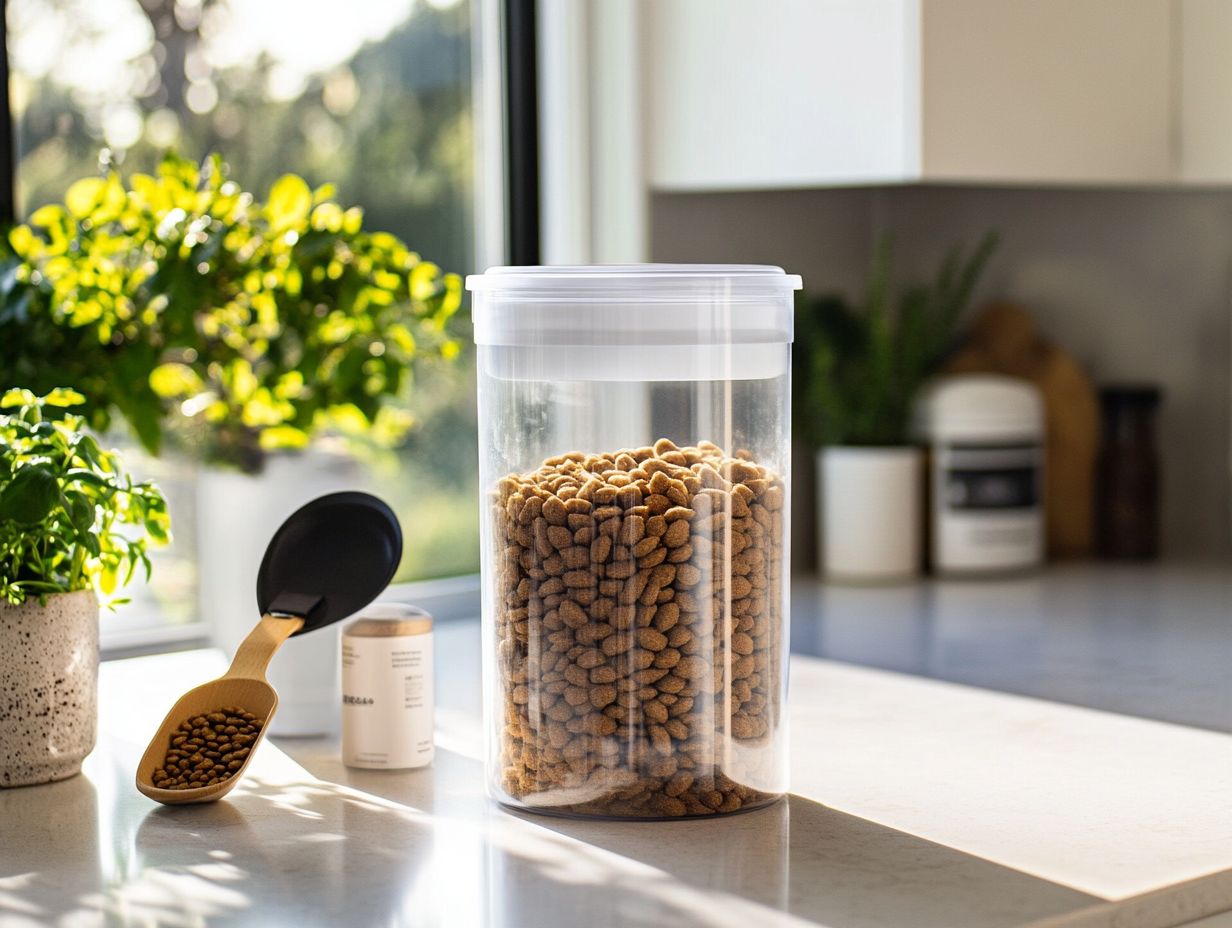Proper storage of dry cat food is essential for maintaining its freshness and nutritional value, particularly because cats, as obligate carnivores, have specific dietary needs that require careful handling to avoid nutrient loss. Whether it’s dry cat food or wet cat food, correct storage practices ensure the health of our pets.
This guide explores effective storage methods, including the importance of using airtight containers and the best places to keep your cat’s food. It also covers key dos and don’ts to prevent spoilage, such as avoiding moisture exposure, and helps you recognize signs that your cat’s food has gone bad.
Keep your cat happy and healthy by ensuring their food stays fresh! Consider using automatic pet feeders to manage portions and maintain freshness, but remember to check the food regularly and not rely solely on the feeder for freshness.
Disclaimer: Always consult your veterinarian for personalized feeding advice, especially when considering any significant changes to your cat’s diet or feeding practices.
Key Takeaways:

Why Is Proper Storage of Dry Cat Food Important?
Proper storage of dry cat food is essential, as improper practices can lead to degradation, mold growth, and contamination with harmful bacteria such as Salmonella and E. coli. Preservatives like BHA, BHT, and tocopherols can help maintain the food’s integrity.
Understanding the significance of proper dry cat food storage extends beyond merely preserving taste and aroma; it plays a crucial role in preventing pet illnesses and supporting pet diets. By minimizing contamination risks and maintaining the vital nutrients that pets require, proper storage ensures the health and well-being of our feline companions. For more information, check out this guide on how to properly store dry cat food.
What Are the Best Ways to Store Dry Cat Food?
To keep dry cat food fresh and maximize its shelf life, the best approach is to store it in airtight containers to minimize exposure to humidity and temperature fluctuations. Before feeding, always check expiration dates to ensure the food meets nutritional standards and does not pose health risks. Whenever possible, it’s also advisable to leave the food in its original manufacturer’s packaging, according to recommendations from pet food manufacturers.
1. Keep the Original Packaging
Storing dry cat food in its original packaging helps maintain its freshness and preserves its nutritional value, as these packages are specifically designed to protect the food from exposure to air and moisture. Each package typically includes a ‘best by’ date, which provides pet owners with essential information about the optimal time frame for consumption, ensuring that cats receive the maximum nutritional benefit.
Additionally, details regarding any preservatives used offer reassurance about the safety and quality of the food. Dry cat food can last longer when stored in its original packaging in a cool, dry place, away from direct sunlight and moisture. If the package remains unopened, transferring the food to an airtight container can further enhance its freshness.
2. Store in a Cool, Dry Place
Storing dry cat food in a cool, dry place is essential for preserving its quality. This practice helps prevent exposure to moisture and maintains the proper temperature, both of which are critical for maximizing shelf life and ensuring food safety. Extreme fluctuations in temperature should be avoided, as this can affect the integrity of the food.
The ideal temperature range for storing this type of food is typically between 50°F and 70°F. If the environment is too warm or the humidity levels are too high, important nutrients can break down, and mold growth may occur, posing a danger to a cat’s health.
Cat owners should be mindful of these factors, as improper storage can lead to a loss of nutritional value and potentially make the food unsafe for their pets. A stable, dry environment is vital for protecting the health of our beloved companions.
3. Use Airtight Containers

Signs of Spoilage
- Unpleasant odor
- Change in texture (e.g., clumping or excessive moisture)
- Visible mold
- Insect presence
When selecting pet foods, consider the ethical aspects of sourcing. Choose brands that prioritize high-quality animal protein sources while avoiding plant-based fillers, aligning with AAFCO and WSAVA standards.
Using airtight containers for dry cat food is one of the best practices to prevent exposure to moisture, odors, and nutrient degradation, ensuring that the food remains fresh for a longer period. This approach not only maintains palatability but also preserves nutritional quality. It is recommended to consult current veterinary research or guidelines from authorities like AAFCO or WSAVA to support these practices.
Airtight containers made from plastic (preferably BPA-free), stainless steel, or glass each offer distinct advantages. Plastic containers are lightweight and typically feature easy-to-use lids. Stainless steel containers are durable, rust-resistant, and provide effective insulation against pests. Glass containers are non-reactive and allow pet owners to see the contents easily, making it simple to gauge how much food is left. However, be cautious with glass, as it can break, and ensure plastic containers are safe for food use.
All of these materials protect against pests and help maintain the freshness and quality of the food, ensuring that essential nutrients are preserved. Consider using vacuum sealing techniques for opened cat food to further extend its shelf life. Additionally, consult with your veterinarian for personalized feeding advice, especially concerning specific dietary needs or health conditions.
4. Avoid Exposure to Sunlight
To prevent nutrient breakdown and maintain the quality of dry cat food, it is essential to avoid exposing it to sunlight during storage, as UV rays can degrade important vitamins and minerals. These ultraviolet rays not only diminish the food’s nutritional content but also create an environment conducive to food contamination, which can be harmful to cats. Check for signs of spoilage like odor, texture changes, or visible mold before feeding.
To mitigate these effects, dry cat food should be stored in a dark, cool place, preferably in opaque containers that block out light. An organized storage area free from direct sunlight is a simple yet effective way for pet owners to help preserve the food’s freshness. Using airtight containers further reduces exposure to light and moisture, thereby extending the shelf life and safety of cat food.
What Are the Dos and Don’ts of Storing Dry Cat Food?
Understanding how to properly store dry cat food, as well as what practices to avoid, is essential for maintaining its quality and safety. Adhering to proper storage methods will help reduce the risk of spoilage and ensure that cats receive a healthy diet.
Do:
Ensuring the quality and safety of dry cat food involves regularly checking the expiration date, keeping the food away from moisture, and cleaning the storage container to prevent contamination. Establish a regular cleaning routine using safe cleaning agents that won’t leave harmful residues.
Regularly checking the expiration date is crucial, as expired food can harbor harmful bacteria and lose nutritional value, potentially compromising your pet’s health. Similarly, keeping the food away from moisture is vital; high humidity levels can lead to mold growth and spoilage, making the food unsafe for consumption. Maintaining a clean storage container is essential to avoid cross-contamination from residues or pests.
By adopting these practices, pet owners can help preserve the integrity of the food, significantly reduce the risk of foodborne illnesses, and ensure their feline companions receive the high-quality nutrition they deserve.
– Check the Expiration Date
Knowing the expiration date for dry cat food is crucial, as it indicates the timeframe during which the food remains safe for your cat and retains its nutritional value. Manufacturers determine these dates by testing the food’s shelf life under various storage conditions, evaluating moisture content, and assessing the stability of nutrients over time.
Allowing pets to consume expired food can lead to a loss of essential nutrients vital for their health, as well as potential food contamination. As ingredients degrade, the food may lose its intended purpose and develop harmful bacteria, which can cause gastrointestinal upset or more serious health issues. Specific examples include vomiting, diarrhea, or even poisoning. Therefore, it is important to pay close attention to these expiration dates.
– Keep the Food Away from Moisture and Sunlight
Proper storage of dry cat food requires keeping it away from moisture and sunlight, as excess humidity can promote mold growth and degrade essential nutrients needed for your cat’s health. When moisture infiltrates storage areas, bacteria and fungi can multiply, making the food unsafe for consumption.
To minimize the risk of moisture exposure, cat food should be stored in airtight containers, which limit air and humidity exposure. Additionally, using dehumidifiers to maintain dry storage conditions can significantly reduce moisture risk. Regularly checking storage conditions and rotating food stocks will help ensure your cat always has access to fresh, healthy food.
– Clean the Storage Container Regularly
Regular cleaning of the storage container is vital to maintain the integrity of dry cat food. An improperly cleaned container can harbor bacteria or residues that may be harmful to your pet. Establish a routine that includes washing containers with hot, soapy water, rinsing thoroughly, and allowing them to air dry. Avoid using old food containers not originally meant for pet food storage to prevent contamination.
Don’t:
- Do not use old food containers not originally meant for pet food storage.
- Avoid not adhering to proper sealing practices, as this can expose food to moisture and pests.
- Do not overlook checking for signs of spoilage, such as odor, texture changes, or visible mold.
Cleaning the food storage container used for dry cat food is essential for maintaining food safety according to guidelines from the AAFCO and WSAVA. Regular cleaning helps prevent contamination by bacteria or residues that could compromise the quality of the food. It is recommended that cat food storage containers be cleaned at least once a month to eliminate harmful microorganisms and preserve food freshness. For optimal results, use unscented, biodegradable soaps and ensure that any disinfectants used are pet-safe.
In households where cats are prone to spilling or wasting food, more frequent cleaning may be necessary. Typically, warm soapy water is sufficient for cleaning the storage container. However, in some cases, a deeper cleaning may be required, which can be achieved using pet-safe disinfectants or a vinegar-water solution. It is important to allow the containers to dry completely before refilling them with food, as moisture can promote mold growth. By following these best practices, you can ensure the safe and palatable storage of cat food. For more tips on this topic, check out How to Properly Store Dry Cat Food.
Don’t:
The “don’ts” of cat food storage are just as crucial as the “dos.” It is important not to mix old and new food, store dry cat food at high temperatures, or leave the bag open, as these practices can impact the nutritional value and food quality.
Mixing old and new food can disrupt the balance of nutrients and lead to digestive upset in pets, while also potentially introducing bacteria from the older stock. Storing dry cat food at high temperatures accelerates spoilage and nutrient degradation, creating a more favorable environment for pests and mold growth. Nutrient breakdown due to such practices can affect pet health significantly.
Leaving the bag open allows moisture and air to enter, which hastens oxidation and makes the food less palatable, as well as increasing the risk of contamination. Such exposure can also allow for the growth of molds and harmful bacteria. Although these “don’ts” may seem minor, they can have significant long-term effects on a pet’s health, potentially leading to dietary deficiencies and illnesses.
– Mix Old and New Food
Mixing old and new dry cat food can lead to potential food safety risks, as older food may contain degraded nutrients and could be at risk of contamination. When these different batches are combined, it can create an uneven distribution of nutrients, potentially depriving cats of essential vitamins and minerals necessary for their health.
Additionally, there is a concern about introducing harmful bacteria that may have developed in the stale food, posing a risk to feline digestive systems. Such practices not only compromise the nutritional value of the meal but may also result in gastrointestinal distress, which could lead to further health complications if not addressed promptly.
Therefore, cat owners should carefully manage their pet’s diet to ensure both safety and overall well-being, using proper storage practices such as keeping food in a sealed container.
– Store in High Temperatures
Heat can adversely affect the quality of dry cat food by breaking down essential nutrients, increasing the risk of spoilage, and posing health hazards for your cat. Specifically, heat can cause preservatives in the food such as BHA, BHT, and tocopherols to degrade, allowing harmful bacteria to thrive and potentially making your cat ill.
To mitigate these risks, dry cat food should be stored in a cool, dry place, away from direct sunlight and heat sources, such as a pantry or cupboard. Additionally, using airtight containers made of plastic, stainless steel, or glass can further reduce long-term exposure to air and moisture. Maintaining a room temperature below 70°F can significantly enhance the safety and shelf life of the cat food.
– Leave the Bag Open
Leaving a bag of dry cat food open exposes it to air, moisture, and contaminants, which can compromise its freshness and overall safety. Failing to seal the bag properly after each use not only decreases the quality of the food but also poses health risks to pets, increasing the chances of food contamination.
Prolonged exposure to environmental elements, such as humidity and fluctuating temperatures, can lead to mold growth and spoilage, making the food unpalatable or even harmful. Additionally, the delicate balance of nutrients may degrade, resulting in an imbalanced diet for beloved feline companions. It is vital to be aware of moisture exposure and use proper storage techniques.
Considerations for Different Life Stages
Cat food storage needs may vary based on life stages. Kittens require nutrient-dense diets, while senior cats may need special formulations that are easier to digest. Pregnant or nursing cats have increased nutritional needs, necessitating careful storage to maintain food quality. Always consult with a veterinarian when making significant changes to a cat’s diet.
Allergens and Spoilage Signs
Be aware of potential allergens in certain cat foods. Improper storage can exacerbate these issues, leading to allergic reactions in sensitive cats. Common signs of spoilage in dry cat food include unusual odors, discoloration, or changes in texture. If you notice any of these signs, it is best to discard the food to ensure your cat’s safety.
Ethical Considerations
Consider the ethical implications of pet food sourcing. Sustainable practices not only benefit the health of your cat but also align with the well-being of the planet. Supporting brands that prioritize ethical sourcing and environmentally friendly practices can contribute positively to both.
It is crucial for pet owners to recognize that taking a few extra seconds to secure the bag or transfer the food into an airtight container that is sealed tightly can protect their cat’s health and ensure they receive the appropriate nutrition they deserve.
How to Tell if Dry Cat Food Has Gone Bad?

Signs that dry cat food has gone bad include any visible signs of mold, unusual odors, and changes in your cat’s eating habits. Recognizing these signs is crucial for maintaining your cat’s health. Always check the expiration date and perform regular food inspection to ensure food safety.
1. Check for Signs of Mold or Insects
Mold and insect contamination are serious concerns with dry cat food, as they can indicate poor quality and pose significant health risks to your cat. It is important to be aware of the risks associated with pathogens such as Salmonella and E. coli, which can be harmful if ingested. Therefore, it is essential to inspect for these issues during food assessments. Additionally, keeping food storage areas clean can help prevent contamination.
Regular visual inspections should be conducted to evaluate the safety and quality of your cat’s food. For tips on keeping dry cat food fresh, check out How to Properly Store Dry Cat Food. Consider using food-grade buckets and vacuum sealing techniques for optimal food storage. Signs of mold on dry food include:
- Unusual colors
- Fuzzy growths
- Off-putting smells
Indicators of insect contamination may be small holes in the packaging or food, as well as visible insects crawling or flying around the food. If you notice any signs of mold or insect activity, it is crucial to discard the contaminated food immediately to ensure your cat’s safety. Implementing a food rotation system can also help maintain food quality.
Always strive to provide your pet with the freshest and uncontaminated food to keep them healthy and happy.
2. Smell the Food
Check the dry food for any changes in odor, as this can indicate its freshness. A rancid or unusual smell may signal spoilage. For all types of food, smell is often an early indicator of deterioration. Regularly inspect any opened cat food for these signs.
If food has a sour, musty, or otherwise unpleasant odor, it is advisable to err on the side of caution and discard it. The relationship between smell and safety is crucial, as harmful bacteria that can cause spoilage may not always be visible. Trust your nose; if something smells off, it’s better to throw it away. Regular checks can prevent pet health issues. If mold is present, be sure to discard the food immediately regardless of smell.
Additionally, regularly inspect storage conditions to ensure that food is kept in a cool, dry place.
3. Observe Your Cat’s Behavior
Your cat’s behavior regarding dry cat food can provide insight into its freshness. A refusal to eat or a lack of enthusiasm may indicate that the food has spoiled. Changes in eating habits are often a sign that the food is stale or contaminated, which can lead to appetite issues and gastrointestinal problems. Consider offering smaller portions to monitor your cat’s response effectively.
Symptoms such as vomiting, diarrhea, or lethargy are common adverse reactions following the consumption of expired food. Therefore, it is crucial to observe your cat’s normal behavior to help ensure its long-term health. Consult with a veterinarian to tailor your cat’s diet according to its specific health needs.
Regularly checking labels, storage conditions, and expiration dates are effective preventative practices. Utilizing automatic pet feeders can also help maintain consistent food inspection and delivery.
Frequently Asked Questions
What is the best way to store dry cat food?

The best way to store dry cat food is in an airtight container, made of plastic or metal, in a cool and dry place to prevent humidity and temperature fluctuations.
Why is it important to properly store dry cat food?
Proper storage is vital to prevent nutritional degradation and ensure safety, maintaining the quality of the food and protecting your cat’s health.
Properly storing dry cat food helps ensure its freshness and prevents it from spoiling, which can lead to potential health issues for your cat, such as gastrointestinal upset and exposure to harmful bacteria.
Can I leave dry cat food in its original bag for storage?
It is not recommended to leave dry cat food in its original bag for storage, as the bag can tear or be exposed to air, leading to the food becoming stale. Consider transferring it to an airtight container for better preservation.
How long can I store dry cat food?
The recommended shelf life for dry cat food is usually around 6-8 months, but it ultimately depends on the type and brand of food. Always check the expiration date on the packaging to ensure proper storage. For optimal storage, keep the food in a cool, dry place away from direct sunlight and maintain humidity levels below 15%.
Should I store dry cat food in the refrigerator?
No, it is not necessary to store dry cat food in the refrigerator. In fact, storing it in the fridge can introduce moisture, which can cause the food to spoil faster. Utilize a dehumidifier if needed to reduce humidity.
Are there any specific storage tips for keeping dry cat food fresh?
Yes, it is important to keep the storage container clean and dry, and to not mix old and new food together. It is also recommended to store the food away from direct sunlight or heat sources. Consider using vacuum sealing to extend the food’s shelf life. Additionally, check for signs of spoilage, such as changes in smell, texture, or the presence of mold.
Properly stored food is crucial for maintaining your cat’s health as an obligate carnivore. Following guidelines from organizations like AAFCO and WSAVA regarding proper food storage practices can help ensure your cat receives the nutrition it needs.
Consulting with a veterinarian regarding any specific dietary needs or concerns related to food storage, especially for cats with health conditions, is always advisable.